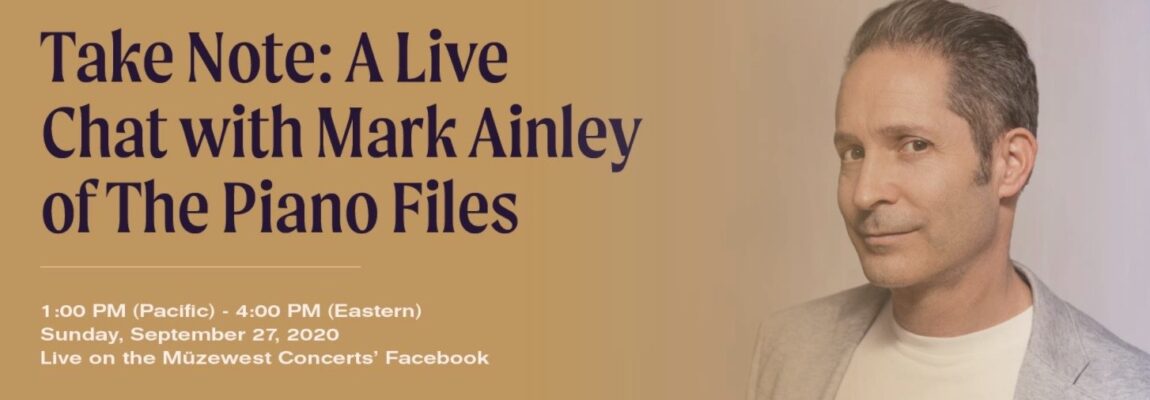On September 27, 2020 I had a wonderful conversation about piano performance and interpretation with Jennifer West, artistic director of the local Müzewest Concerts and a big piano aficionado. Our conversation covered a lot of ground in its 53 minutes.
Here is a YouTube link to our Zoom discussion:
You can also listen on Spotify:
And it’s also on Apple podcasts:
and on other podcast platforms – click here to find yours
Below that are some of the recordings that I mention in our conversation:
I spoke about the profound experience of first hearing Josef Hofmann playing Beethoven’s Waldstein Sonata in recital in 1938 and how it was a completely life-changing event, how nothing I had read about Hofmann’s playing could prepare me for what this performance was actually like. That experience shifted my perspective of what is possible interpretatively (and to be clear, I’m not saying one should or shouldn’t emulate this) and how descriptions of playing cannot fully communicate what an artist does.
Here is the recording of Rachmaninoff playing Chopin’s famous Nocturne Op.9 No.2, which I mention some university students having been surprised by because it didn’t match their perception of how the work should be played. And yet Rachmaninoff was born less than 25 years after Chopin died, so he was much closer to the culture of Chopin’s music than we are.
In our conversation I mentioned how I think the sound of newer recordings is not like what we hear in concert, and that some earlier recordings capture piano tone better than new ones. Here’s an example of a recording from the 1920s – 1928 to be precise – with what I think is wonderful sound … and the playing is absolutely divine too:
Here is an example of Bach played on the piano with beautiful pedal effects, dynamic gradations, and tonal colours, by a sorely forgotten artist:
Jennifer asked me about the restoration of historical recordings. Here’s the video I mentioned that shows how I splice together different parts of an early recording made on 78-rpm discs, each of which would hold only 4 to 5 minutes of music, which meant that longer works were spread apart several records (just like YouTube used to cut videos into shorter segments). I explain this a little bit and show how I do this kind of editing on computer.
This is the wonderful recording by Egon Petri of Liszt’s Un Sospiro that sounded so incredible when an original 78rpm disc was played on my old player in my basement in Montreal. I wish this transfer sounded as good, but it’s still pretty amazing (despite the crackle), and the performance is wonderful.
I mention how the producer Bryan Crimp played me a transfer he had made of the great Ignaz Friedman’s recording of Chopin’s 2nd Impromptu on giant speakers. While this won’t sound the same as that experience, this performance is certainly one that needs to be heard by all piano lovers.
I also mentioned how easy it is to hear and see so many amazing recordings now and how difficult it used to be – I gave, as an example, the film footage of Francis Poulenc playing his 2-piano concerto with Jacques Fevrier. If you even knew it existed, you had to fly to Paris and pay to see it at the national library… but now you just have to click a button… right here!
I referred to a specific listening experience from some 30 years ago of Swiss pianist Edwin Fischer playing a specific Bach Prelude & Fugue – the space I was in at that particular moment, I heard the music in a particularly dimensional way that I still recall decades later. These kinds of experiences can happen when we listen attentively as opposed to passively.
A story I referred to in the conversation: the great Arthur Rubinstein recounting how some pianists used to talk to each other on stage while in performance. He was a great story-teller and this particular tale tells us how different the concert experience used to be.
An example of Dinu Lipatti’s sumptuous pianism, from that legendary ‘last recital’ that caught my eye when I first saw his name:
Near the end of the talk, I referred to Alfred Cortot, the legendary pianist, teacher, and writer, who many young pianists nowadays have fortunately heard of. He is one of my all-time favourite performers: here is one of my favourite recordings of this great artist.
There are countless other recordings I could have mentioned, all of which I consider essential listening to understand the possibilities of interpretation and pianism, but these are those that came up in conversation and are, I believe, an excellent introduction to some of the magical artistry that can be heard in these precious sonic documents. I am grateful to Jennifer for having invited me to have this conversation and for having asked such important questions so that we could explore the topic with this depth.

Comments: 2
As always, so illuminating! A reminder that there piano players, and then there are ARTISTS!
Thanks so very much for this delightful and absorbing offering!
Thank you so much, Leon – I’m so glad you enjoyed it. Yes indeed, artistry is a whole other thing… there IS a difference between ‘performance’ and ‘interpretation’…